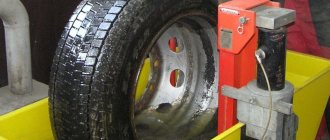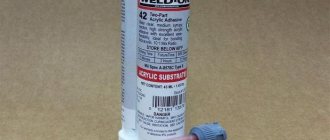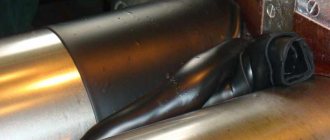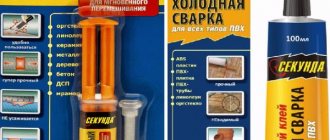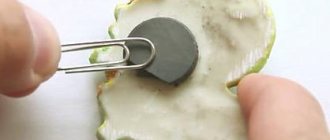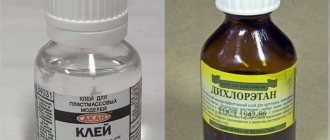There are several ways to repair a puncture or cut in a bicycle tube, one of which is hot or cold vulcanization of the tires. This method can be confidently called reliable and durable; a wheel secured with raw rubber will serve like new and will not go flat at the most unexpected moment. You can easily carry out such repairs yourself, both at home and outdoors on a hike, if you have some necessary parts. The hot vulcanization method differs from the cold method only in how the patch applied to the wheel is fixed - with or without heating.
What is vulcanization? This is a chemical process due to which, with the expenditure of heat, the strength properties of rubber improve, it becomes elastic and hard. You can apply a patch to a puncture using a piece of an old tube or a ready-made patch from a repair kit, and to secure them you need raw rubber with your own hands, which is sold in rolls with a protective film. This is a very plastic material, it sticks to any surface, easily sticks together into a lump, etc. raw rubber instructions for use are indicated on the packaging.
- There are two types of vulcanization - cold and hot, let's look at both of them in more detail.
Application of cold vulcanization
The material for such repairs appeared back in 1939 in the USA, almost immediately began to be successfully used and is popular among cyclists and motorists around the world to this day. With its help, you can easily and hassle-free repair any camera; the cold method is very easy to use at home. For the convenience of consumers, some manufacturers offer ready-made repair kits (cold wet rubber, instructions for use are indicated on the packaging), which include several patches of various sizes in the form of a patch, sandpaper, which is used to clean a puncture site or scratch on the rubber. , as well as a special quick-drying adhesive for cold vulcanization. It is this that reacts with the layer of raw rubber on the patch - it is applied in bright color around black. This causes a vulcanization process, making the rubber of the chamber easily glued together without heat (i.e. cold process). This method is best suited for repairing wheels on the go, when there are no more tools at hand. You won't find a single cyclist who hasn't been helped out by a kit like this at least once in his life. It does not take up much space in a bag or backpack, and its importance is difficult to overestimate, especially if you are alone on a trip without friends far from the city. The entire process of repairing a tire using cold vulcanization using a patch for the inner tube will take the cyclist no more than ten minutes, and the wheel will be like new.
Do-it-yourself hot vulcanization technology for tires
This technology is used a little longer than cold technology. At a time when there were not so many tire shops around, car and bicycle enthusiasts repaired their vehicles in the garage using exactly this method, which uses an electric or gasoline vulcanizer, which can be easily assembled with your own hands. The technology here is as follows: the master burns gasoline, which warms up the rubber using a piston. As soon as the temperature rises to 90 degrees, the raw rubber for vulcanization begins to strengthen; if you raise the temperature to 147 degrees, the process goes noticeably faster and with better quality. But it’s better not to raise it above 150, because... the material begins to deteriorate and loses its properties. After 160 degrees, raw rubber begins to char. The ideal warm-up time for hot vulcanization of raw rubber is about 8-10 minutes. A fragment of material is applied to the puncture site on the camera and compressed using a clamp so that during the chemical reaction bubbles do not form and air does not collect, forming dangerous voids.
Hot vulcanization using raw rubber
Raw rubber is a material that can change its properties under the influence of high temperature, weld into a single composition with the base of a tire or tube, turning into ordinary rubber as a result of heat treatment. The reverse process is no longer possible here, but due to the property of reliably setting rubber, it is able to repair quite serious cuts and punctures, and restore the performance of the tire/tube by 90-100% (in many cases).
Hot vulcanization of tires and tubes is always carried out using a press; welding of rubber with rubber is carried out over a certain period of time; the time of welding of rubber depends on the depth/area of the damaged area. It takes 4 minutes to seal every millimeter of cut; therefore, a hole 3 mm deep will require vulcanization for 12 minutes. But the process of heating the rubber itself is not limited to these minutes; here it should be taken into account that a standard industrial vulcanizer must warm up for 20 minutes, another 40 minutes are spent on warming up the pressure equalization pads (if they are provided in the design of the vulcanizer).
The standard vulcanization temperature is 140-150 degrees, and you can repair a tire, bicycle or car tube not only with a factory vulcanizer, but also with the help of a home-made device; for this you can use household heating devices, various proprietary designs.
Read also: Muscular traction fan
Cement for vulcanization and its application
Another alternative option for repairing bicycle wheels while traveling is a can of cement vulcanizer. You can buy them, for example, at the car market - this material is very popular among car enthusiasts. The composition is sold in tin and aerosol cans under pressure from brands such as Abro, BL, Zefal, Top RAD and many others. In terms of their composition, they are not hazardous to health and are not toxic, because... they do not contain chloride and aromatic hydrocarbons, so they can be used freely both at home and outdoors without a protective mask. In order for tire cementation to occur, a temperature of 18 degrees Celsius is required. The composition is also used for hot vulcanization (150 degrees required). To repair, you need to remove the foreign object that caused the puncture from the rubber of the inner tube, fill the inner tube with a cement vulcanizer through the nipple, slightly inflate it with a pump and ride a bicycle for 2-3 kilometers to adjust the pressure in the wheels. This tire repair technology is simple and is also used everywhere. To consolidate the result, it is possible to use a patch of plaster followed by the hot vulcanization method - exactly the same as described in the instructions above. The technology is suitable for any tire cuts. In this case, the patch for repairing the tubes is applied before filling the tire with cement.
There are more and more tire shops. However, on the road, both a cyclist and a motorist, a situation may arise when a tire breaks and the workshop is far away. A car enthusiast often has a spare wheel, but a bicycle driver does not have such a wheel, and it becomes necessary to vulcanize the inner tube on the road.
Two-step tire repair method
It was this method of repair that once came to Russia from abroad and became known as “cold” vulcanization.
It is produced in two stages. First, the technician cleans out the damage and performs external cosmetic repairs to the tire by “hot” vulcanization of the raw rubber. He then re-sands the repair surface inside the tire and installs a chemical patch. According to the recommendations of the world's leading manufacturers, after repair using the “cold” method, the tire should be left for at least 24 hours at an ambient temperature of at least 20°C. The lower the temperature, the longer the repaired tire needs to sit.
At first, when self-vulcanizing repair materials just appeared on the market and were a novelty, they were presented by sellers as a panacea for all ills. But as practical experience accumulated, along with the advantages, the disadvantages of the two-stage method also became obvious. Over time, it became clear that “cold” vulcanization does not give the desired results, and the long period of exposure after repair creates problems with high machine traffic and forces craftsmen to neglect technical conditions.
Repair using the two-stage method is carried out, as a rule, in workshops where there is only a C-shaped vulcanizer with a flat heating element of a small area. In Russia, such vulcanizers are widely represented by products of foreign and domestic manufacturers. But, despite the attractive appearance, the design features of these vulcanizers do not allow achieving high quality repairs. Their disadvantage is the small area of the heating element, which cannot compress the damage and therefore causes swelling on the tire. Such vulcanizers can only be recommended for repairing very minor damage.
In order not to disrupt the tire repair technology, the vulcanizer must be additionally equipped with heating elements of a larger area, which will allow the entire repair area to be compressed without deforming the tire frame.
It should be noted that cold vulcanization is very demanding in terms of technology and it does not forgive mistakes. Whether it’s dried out adhesives or an old patch, you won’t see a quality result anymore.
The reality is that failure to comply with all technological conditions is a common occurrence with the two-step repair method. The lack of the necessary tools, insufficient qualifications of personnel, and a simple lack of time lead to unsatisfactory results.
Therefore, a less problematic one-stage repair method is more suitable for Russia.
Concept of vulcanization
Vulcanization is a chemical process during which raw rubber, improving the properties of the material in strength and elasticity, becomes rubber. In fact, rubber can be used as a special glue to seal a puncture in an inner tube or tire. Rubber vulcanization processes are as follows:
- electric;
- sulfuric;
- hot;
- cold.
Types of rubber
Rubber is one of the few materials that has different hardness. Depending on the percentage of sulfur, it is:
- soft – contains up to 3% sulfur;
- semi-solid – from 4 to 30% sulfur;
- hard – more than 30%.
Rubber is a natural material, and as a rule, products made from natural ingredients are of the highest quality and most durable. Therefore, components for bicycle and car wheels are made of soft rubber, which is based on rubber.
One-step tire repair method (Thermopress method)
This method was developed specifically for Russian roads, taking into account their national characteristics. It differs from “cold” vulcanization in that “hot” vulcanization of raw rubber and chemical vulcanization of the patch occur simultaneously under a pressure of 4 kg/cm and a temperature of 130-150°C. It takes 40 to 90 minutes to repair a passenger tire, and 2-4 hours for truck tires, depending on the thickness of the area being repaired.
To work using this method, our company has developed vulcanization systems for the entire range of tire sizes:
- “Thermopress-1” for repairing tires of passenger cars and light trucks;
- "Thermopress-19" for tires of SUVs and trucks;
- “Thermopress-520”, “Thermopress-820” and “Thermopress-1100” for repairing truck, agricultural and quarry tires;
- "Thermopress-K" for repairing tires of mining dump trucks, graders and other wheeled special equipment.
Thermopress vulcanizers are distinguished by their versatility: they allow repairing truck tires of a wide range of sizes and with high technological parameters. We have developed a 2-post vulcanizer with an offset specially for express repair of passenger tires. Its design is the most convenient for repairing passenger car tires up to 20 inches in size.
The indisputable advantage of the one-stage method is the increased bond strength of the patch to the tire, greater than with cold repair. This becomes possible due to the fact that the patch, adhesives and raw rubber are simultaneously heated under pressure, which significantly increases the activity of the glue, and the chemical layers of the patch are “melted” into the tire. In this case, the repair time will be minimal, while the “cold” vulcanization technology requires the plaster to be left in place for at least 24 hours.
It is also important that the one-step method allows you to correct errors made during the preparation of the tire, even at the last stage of repair. When the repaired area and the patch are simultaneously heated under pressure, there is a sharp increase in the strength of the connection between the patch and the tire. The increase in strength with a margin covers the consequences of errors made during the repair process (see “Characteristic errors made during repairs”).
Electrical vulcanization of rubber
In general, vulcanization can be cold or hot. The electrical vulcanization process is a hot method. An electric stove with a ceramic heater is used as a heater at home; a hair dryer or a regular iron is also suitable. The optimal temperature for this method is 145C o. To determine the temperature, you can also use available means, for example, if a sheet of paper begins to char, it means that the temperature has reached the required values.
Electrical vulcanization of rubber
There are also special clamps with a heating element. Such devices can operate from a 220V household network, from a car battery, through a cigarette lighter socket, or from their own battery. It all depends on the performance of each device. These clamps are easy to use; you need to attach a rubber patch to the camera, clamp it and plug it into the network.
Sulfur vulcanization of rubber
After rubber vulcanization
This operation consists of a chemical reaction in which sulfur atoms are added to the rubber. When added up to 5%, it produces raw materials for the manufacture of tubes and tires. In the case of gluing two elements, sulfur helps connect the rubber molecules, forming a so-called bridge. This procedure refers to the hot method, but it is unlikely that it will be possible to do it on a hike or on the highway.
Hot vulcanization
Rubber, as a raw material, has the property of being welded into a single composition at a temperature of 150 °C. As a result of this process, the rubber becomes rubber and cannot return to its original position. Thanks to its capabilities, rubber can fix any punctures and cuts in the tube and tire.
It is necessary to vulcanize rubber using a hot method, only using a press. The depth and area of the cut will tell you how long to weld. Typically, it takes 4 minutes of cooking to repair a 1mm cut. Accordingly, if the cut is 4mm, then it needs to be vulcanized for 16 minutes. In this case, the equipment must be warmed up and configured.
By performing hot vulcanization at temperatures above 150C o, you can ruin the rubber and achieve nothing, since the material will deteriorate and lose its characteristics.
Using clamps or a press allows you to properly patch the damage. After finishing the work, you should make sure that there are no voids or air bubbles in the seam. If there are any, you need to clean the puncture site from fresh rubber and repeat the whole process again.
In order to hot seal a camera at home, you must do the following. From raw rubber, you need to cut a piece slightly smaller than the patch itself. The tube or tire is cleaned slightly wider at the damaged area, to a rough state, and then degreased with gasoline. When preparing the patch, you need to cut the chamfer at an angle of 45°, also sand and degrease. Then we cover the puncture site with a patch, clamp it in a vice and heat it to the desired temperature.
If you dissolve raw rubber in gasoline, you can get a special glue for rubber, the use of which improves the quality of the seam. Particular attention should be paid to temperature conditions. Vulcanization is carried out at a temperature of 140 - 150 ° C; if there is a smell of burnt rubber, it means the patch has overheated, and if it has not merged with the overall product, then it may not have reached the required temperature. To prevent rubber from sticking to metal, you need to place paper between them.
Vulcanization of the chamber with raw rubber
The vulcanization process of a bicycle tube is carried out according to the following principle:
- The place in the chamber where the hole is located is prepared.
- Raw rubber is applied to this place.
- Compression is carried out using a heated press.
The heating temperature of raw rubber is 147 degrees. If you raise it to 150, it will collapse, and at 160 the charring process will begin. Exposure time - 8-10 minutes.
Instructions for vulcanizing a chamber at home consist of the following steps:
- Use sandpaper to clean the location of the hole. For this purpose, the use of an abrasive stone is allowed.
- A patch is cut out of raw rubber, usually round in shape. Its dimensions should cover the hole by at least 2 cm.
- Raw rubber is dipped in gasoline and placed over the hole in the chamber.
- Paper is placed on the rubber so that it does not stick to the vulcanizer.
- A vulcanizer element with a spiral is installed on top, and a lining is installed on the bottom.
- The clamp is used to apply pressure.
- Voltage is applied to the terminals.
- Cooking takes place for 8-10 minutes.
- The device turns off.
- The clamp is not removed until the device and chamber have cooled down.
Once removed, the connection appears as one piece.
Cold vulcanization
Nowadays, using this method is not difficult, since you can purchase a repair kit in every auto or bicycle parts store. The contents of this set may vary, but each one contains patches and special glue.
Cold vulcanization of rubber
The repair procedure in this case is similar to the hot method. You also need to treat the damaged surface with an abrasive, remove rubber dust and degrease. After drying, apply glue to the camera and glue the patch. In this case, it is not the duration of the pressure that plays a role, but its strength. Therefore, it will not be enough to simply press down with a stone; more force is required.
Do-it-yourself cold vulcanization of rubber is a fairly simple process that can be performed wherever you are if you have a special kit. However, raw rubber is not made with your own hands at home. For such work you need special equipment.
Advantages, disadvantages of hot and cold vulcanization
Vulcanizing tires and tubes primarily allows you to save money; it is known that repairing tires is significantly cheaper than buying new wheels. But restoring rubber is not always advisable; much depends on the degree of damage. Each vulcanization method has pros and cons, so the main advantages of the cold method are:
The most noticeable disadvantage of cold vulcanization is the low reliability of the seal: even when repairing a small cut or puncture, it is not recommended to use the car for a long time, it is advisable to drive with low pressure in the tire, and if possible, it is better to immediately contact a tire shop. Direct small punctures can be repaired using a “fungus”, but only when the angle of the damage does not exceed 25 degrees.
Advantages of hot vulcanization:
- low cost of repairs;
- reliability of rubber welding;
- the ability to operate the car immediately after the tube/tire has been repaired;
- admissibility to carry out work in any temperature conditions.
Making a vulcanization device
Each vulcanizer has two main elements - a heating part and a clamping device. The basis of such rubber processing equipment can be used:
- iron;
- “bazaar” electric stove;
- piston from the engine.
In a device with an iron, the heating part is the surface that is used for ironing in everyday life. If we plan to use an electric stove, then the heating coil should be covered with a metal sheet, and when working, you need to place paper between the rubber and the metal. Such a device must be equipped with a thermostat to avoid overheating of the material.
Pros and cons of vulcanization
The main advantage of the tire repair process is that it is cheaper to repair than to buy a new one. However, each situation is individual, so it is important to determine whether repairs will save the situation.
The cold method is quite easy to use, it will not take much time, and the costs will be minimal. The main disadvantage of this method is the unreliability of gluing. This procedure is temporary, and you should contact a service station as soon as possible.
Hot vulcanization reliably welds rubber, allows such work to be carried out at any temperature and has a low cost.
So, you can repair a tube or tire in different ways, but it is better to entrust this work to specialists, because it is for your own safety.
If you find an error, please select a piece of text and press Ctrl+Enter.
Before gluing the inner tubes of car and motorcycle tires with raw rubber, most novice vulcanizers still try to find out the details and features of the use of this material. Moreover, the advertisement can position this product as a product for independent use. But, in practice, not everyone can cope with “home vulcanization”. The technology for using raw rubber should be studied in as much detail as possible even before gluing the parts. For example, if we are talking about covering a punctured hole in a vehicle tire, this type of material is best suited for self-repair.
Hot vulcanization of tires - features and advantages
The process of hot vulcanization of tires is based on heat treatment of the damage site with the addition of rubber (“raw rubber”). Under the influence of high temperature, the rubber components are bonded together, creating a plastic monolithic layer.
Hot vulcanization of tires
Penetrating into the cut site, the heat-treated rubber completely fills the space, preventing dirt and moisture from penetrating into the tire.
Briefly, the hot vulcanization process is as follows:
- The tire is removed from the disk, the cut area is carefully processed with a milling cutter (the main thing is not to damage the cord).
- The treated area is additionally cleaned and degreased.
- A special composition is applied to the cut site in 2 layers.
- The dried damaged area is filled with “raw rubber” layer by layer, after which the tire is sent to a tire vulcanization machine. Heat treatment is carried out at a temperature of 120-140°C.
- For additional strength, a special cord patch is applied to the inside of the tire.
- After the rubber has cooled, the repair site is additionally cleaned with a milling cutter and finishing is carried out.
Advantages of hot vulcanization:
- Price. The cost of eliminating side cuts using this method is lower than buying new tires.
- Reliability. High-quality vulcanization of tires can preserve 90% of the rubber's strength.
- Efficiency of repairs. You can drive with the repaired wheel immediately after the damage has been repaired.
- The versatility of the method. Hot vulcanization can be performed at subzero temperatures in winter, as well as in highly dusty conditions. This means that in case of sudden cuts and the absence of a spare tire, you can call a mobile tire service that will repair the wheel right on the road.
Now about the time standards for tire vulcanization. It takes professionals 1-2 hours to complete a complete repair. Vulcanization of truck tires takes much longer – from 2 to 4 hours.
On average, the price of repairing a side cut of a tire using hot vulcanization starts from 400 rubles. and depends on the characteristics of the damage, tire radius, region and specific workshop.
How to glue with raw rubber: technology features
How to glue a camera with wet rubber in a garage? This should not be done at home, since you will be working with chemically aggressive substances. It is worth adding that there is also a lot of information on how to make raw rubber. In fact, it differs from the usual one only in the absence of heat treatment. But on an industrial scale they produce the material in sheets. If you try to carry out such experiments yourself, you will have to spend a lot of time and effort to knead raw materials based on natural or artificial rubber. To perform the work, you need a special machine with screw-type shafts. At home, it is made from unnecessary equipment, such as a washing machine.
How to seal a hole in a tire with wet rubber? To carry out the work you will need a vulcanizer. The sequence of actions will be as follows:
- The gluing area must be sanded and any found scraps and other elements interfering with the process must be cut off.
- Apply a degreasing compound.
- Cut a patch of the required size from a sheet of rubber and apply it to the surface.
- Clamp the workpiece with a clamp and heat it.
- The vulcanization process takes from 4 to 10 minutes per 1 mm of patch thickness.
Before sealing the camera with raw rubber, you can treat the surfaces with special adhesives. They increase the intensity of the vulcanization process.
Homemade raw rubber production
Rubber, especially artificial rubber, requires a lot of effort to knead. A person does not have enough strength to knead it with his hands like dough. A special device is made for this. Mixing with additives is a labor-intensive and time-consuming process. Substances with different dispersion, specific gravity and physical state must be converted into a homogeneous mass.
You prepare raw rubber yourself in a machine with screw shafts. The screw protrusions grind everything that is put into the container and mix it. The production speed depends on the number of shafts. He is usually alone at home, and it takes a lot of time to bring the mixture to the desired state.
For molding into sheets and strips, two shafts are sufficient, one of which moves, changing the size of the gap, and therefore the thickness of the finished raw rubber. The mass is placed in a storage tank and goes to molding. When deformed, it cools down and loses its ability to flow, becoming tensile.
Equipment for a home workshop can be purchased at a store or made independently. Take the equipment available in the kitchen as samples. The engine will fit from a broken washing machine or any other machine. Automotive belts and pulleys.
